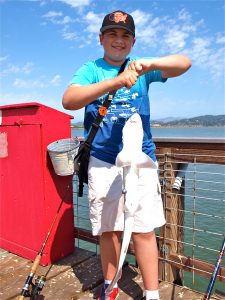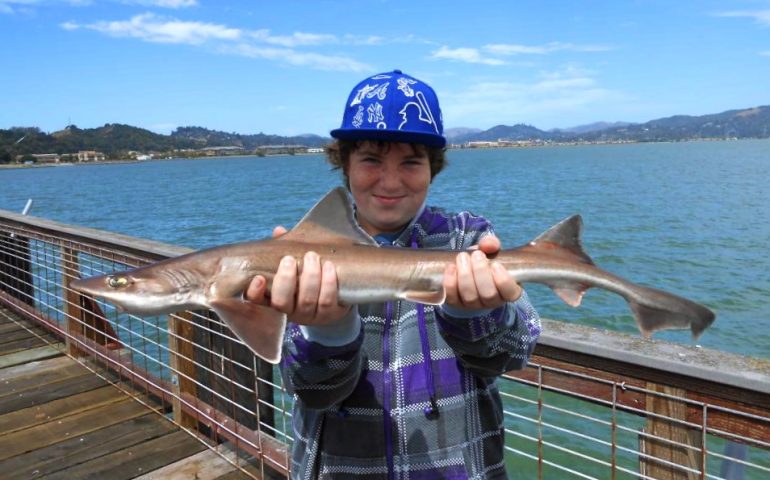Smoothhounds: Family Triakididae
Species: Mustelus henlei (Gill, 1863); from the Latin word mustelus (weasel colored) and henlei (referring to Professor J. Henle, a 19th Century biologist). Class Chondrichthyes, Subclass Elasmobranchii, Superorder Galea, Order Carcharhiniformes, Family Triakidae—Hound sharks.
Alternate Names: Sand shark, mud shark, paloma, dogfish or Henle’s shark. Called cazón pardo or cazón hilacho in Mexico.
Identification: Similar to the leopard shark and gray smoothhound except that the first dorsal is further ahead on top of body, equidistant between origin of pelvic and pectoral fins. Their coloring is red-brown or bronze above, silvery below.
Size: Length to five feet but most caught from piers are under three feet.

Brown smoothhound from the Marin Rod & Gun Club Pier
Range: From the Gulf of California to northern Washington. Most smoothhounds found north of Point Conception are brown smoothhounds; uncommon north of Eureka.
Habitat: From the tropics and the Gulf of California to Northern Washington. Most smoothhounds found north of Point Conception are brown smoothhounds; uncommon north of Humboldt Bay.
Piers: Extremely common at San Francisco Bay piers; one of the most numerous fish at some piers. Best bets: Fort Baker Pier, Angel Island Pier, Port View Park Pier, and all piers along the San Francisco waterfront.
Shoreline: A frequent catch by anglers in San Francisco and San Pablo Bay.
Boats: A frequent catch of boaters and kayakers in Morro Bay, San Francisco Bay, and Tomales Bay.
Bait and Tackle: Will hit almost any bait although squid is the best! Fish with medium tackle and size 4 to 2/0 hooks. If possible, fish at night.
Food Value: A mild flavored flesh suited to several methods of cooking. The best method is probably grilled. It does need to be cleaned properly and kept cool before cooking.
Comments: Although most smoothhound sharks are thrown back, they are a fine meal when cleaned and prepared properly.

Landed one in Humboldt bay, about 30 to 40 yards from shore using dead anchovy bait while fishing for halibut. ~2 feet or so in length. Removed head immediately to bleed it out (was told in the future its best to do the tail first but geez you deal with the thrashing!), then gutted and skinned it.
At home I removed any remaining reddish portion that remained below skin (blood = urea = bad taste/stink) at home, cut it into pieces and marinated in milk overnight.
Drained the milk, seasoned with a sprinkle of salt.
Sliced up an onion and cooked it down in a pan with some avocado oil, and sweated a couple tea spoons of madras curry powder and fried up the fish over medium heat. Thumbs up from my friend!
So much work to prepare and eat the shark. Let the futures one go. – catch and release the best way to fish! Fishman Fishman.
[…] Smoothhounds are small sharks. They only grow to about 3 feet long at most. (Larger sharks eat Smoothhounds, so technically these are not true apex predators.) On both the Atlantic and Pacific coasts, they live in near proximity to the nearly identical Spiny Dogfish. The identifying feature is presence or absence of a spine just in front of first and second dorsal fins. Some people refer to Smoothhounds as just another type of “Dogfish.” https://www.pierfishing.com/brown-smoothhound-shark/ […]